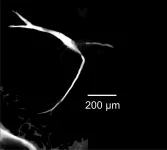INFORMATION:
The research was a collaboration among the Experimental Pathology of Atherosclerosis at CNIC, the Cardiovascular Proteomics groups at CNIC, CIBER de Enfermedades Cardiovasculares, and the Atherosclerosis Research Unit at Aarhus University in Denmark.
CNIC researchers explain how high blood pressure, the most important cause of disease worldwide, acc
The new insight supports the need to keep both LDL cholesterol and blood pressure low throughout life by healthy diet choices, weight control, exercise, and, when needed, by drug therapy
2021-04-12
(Press-News.org) High blood pressure, the most important cause of disease worldwide, accelerates atherosclerosis but the mechanism is unknown. Using gene modified minipigs, researchers from the Centro Nacional de Investigaciones Cardiovasculares (CNIC) and Aarhus University (Denmark), demonstrate that high blood pressure alters the structure of arteries leading to more accumulation of LDL cholesterol and faster development of atherosclerosis. The study has been published in The Journal of the American College of Cardiology (JACC).
Blood pressure-lowering drugs are routinely used to prevent the development of atherosclerosis and heart disease, but the mechanism of this effect is still unknown. People suffering from high blood pressure (hypertension) often have accompanying changes in the hormones that control blood pressure and it has been unclear whether the pressure itself or the hormonal changes are the driver of accelerated atherosclerosis.
To investigate this, researchers from the CNIC and Aarhus University analyzed the development of atherosclerosis in minipigs that were genetically engineered to have high blood cholesterol and develop atherosclerosis.
Minipigs have arteries that are very similar in structure to human arteries and like humans they develop atherosclerosis in the heart when exposed to high blood cholesterol, Dr. Jacob Fog Bentzon comments, coordinator of the study published in JACC. As is also the case in humans, the development of the early stages of the disease is asymptomatic and therefore experiments on atherosclerosis can be conducted in minipigs with high animal welfare.
By manipulating blood pressure in the pigs and by analyzing the effects on arteries in the heart, the researchers found that the direct forces of pressure on arteries leads to structural changes that facilitate the development of atherosclerosis. "Arteries become denser and allow less passage of molecules from the blood. This includes the LDL particles that carry blood cholesterol, which instead accumulate in the innermost layer of arteries, where they drive the development of atherosclerosis", Dr. Jacob Fog Bentzon explains.
This finding uncovers an intimate relationship between the most important risk factors for atherosclerosis, LDL cholesterol and high blood pressure. While it has been known for decades that accumulation of LDL particles in arteries lead to atherosclerosis, the new research shows that high blood pressure accelerates the accumulation of LDL. Therefore, high blood pressure aggravates the effect of having high LDL cholesterol in the blood.
The new insight supports the need to keep both LDL cholesterol and blood pressure low throughout life by healthy diet choices, weight control, exercise, and, when needed, by drug therapy. "It could also pave the way for the development of more effective therapies to offset the detrimental effects of hypertension on atherosclerosis", the researchers conclude.
ELSE PRESS RELEASES FROM THIS DATE:
Breakthrough in plant protection: RNAi pesticides affect only one pest species
2021-04-12
The detrimental impact of pesticides on non-target organisms is one of the most urgent concerns in current agriculture. Double-stranded RNAs (dsRNAs) represent the most species-specific class of pesticides to date, potentially allowing control of a target pest without effecting other species. The unprecedented target-specificity of dsRNA is due to its nucleotide sequence-specific mode of action that results in post-transcriptional gene silencing, or RNA interference (RNAi), in the target species. The development and field use of dsRNAs, via both the insertion of transgenes into the plant genome and the application ...
Brain damage caused by plasticisers
2021-04-12
The plasticisers contained in many everyday objects can impair important brain functions in humans. Biologists from the University of Bayreuth warn of this danger in an article in Communications Biology. Their study shows that even small amounts of the plasticisers bisphenol A and bisphenol S disrupt the transmission of signals between nerve cells in the brains of fish. The researchers consider it very likely that similar interference can also occur in the brains of adult humans. They therefore call for the rapid development of alternative plasticisers that do ...
The COVID-19 pandemic has been linked with six unhealthy eating behaviors
2021-04-12
MINNEAPOLIS/ST.PAUL (04/12/2021) -- A new probe into the lingering impacts of the COVID-19 pandemic revealed correlations to six unhealthy eating behaviors, according to a study by the University of Minnesota Medical School and School of Public Health. Researchers say the most concerning finding indicates a slight increase or the re-emergence of eating disorders, which kill roughly 10,200 people every year -- about one person every 52 minutes.
U of M Medical School's Melissa Simone, PhD, a postdoctoral research fellow in the Department of Psychiatry and Behavioral Sciences, collaborated with School of Public Health ...
Pain receptors linked to the generation of energy-burning brown fat cells
2021-04-12
BOSTON - (April 12, 2021) - A new source of energy expending brown fat cells has been uncovered by researchers at the Joslin Diabetes Center, which they say points towards potential new therapeutic options for obesity. According to the new report, published today by Nature Metabolism, the key lies in the expression of a receptor called Trpv1 (temperature-sensitive ion channel transient receptor potential cation subfamily V member 1) -- a protein known to sense noxious stimuli, including pain and temperature.
Specifically, the authors point to smooth muscle cells expressing the Trpv1 receptor and identify them as a novel source of energy-burning brown fat cells (adipocytes). This should translate into increased overall energy ...
Technique allows mapping of epigenetic information in single cells at scale
2021-04-12
Histones are tiny proteins that bind to DNA and hold information that can help turn on or off individual genes. Researchers at Karolinska Institutet have developed a technique that makes it possible to examine how different versions of histones bind to the genome in tens of thousands of individual cells at the same time. The technique was applied to the mouse brain and can be used to study epigenetics at a single-cell level in other complex tissues. The study is published in the journal Nature Biotechnology.
"This technique will be an important tool for examining what makes cells different from each other at the epigenetic level," says Marek ...
Poop core records 4,300 years of bat diet and environment
2021-04-12
WASHINGTON--Deep in a Jamaican cave is a treasure trove of bat poop, deposited in sequential layers by generations of bats over 4,300 years.
Analogous to records of the past found in layers of lake mud and Antarctic ice, the guano pile is roughly the height of a tall man (2 meters), largely undisturbed, and holds information about changes in climate and how the bats' food sources shifted over the millennia, according to a new study.
"We study natural archives and reconstruct natural histories, mostly from lake sediments. This is the first time scientists have interpreted past bat ...
Exercise benefit in breast cancer linked to improved immune responses
2021-04-12
BOSTON - Exercise training may slow tumor growth and improve outcomes for females with breast cancer - especially those treated with immunotherapy drugs - by stimulating naturally occurring immune mechanisms, researchers at Massachusetts General Hospital (MGH) and Harvard Medical School (HMS) have found.
Tumors in mouse models of human breast cancer grew more slowly in mice put through their paces in a structured aerobic exercise program than in sedentary mice, and the tumors in exercised mice exhibited an increased anti-tumor immune response.
"The most exciting finding was that exercise training brought into tumors immune cells capable of killing cancer cells known as cytotoxic T lymphocytes (CD8+ ...
"Look before you leap:" Cardiologists warn about the risks of vaping
2021-04-12
Philadelphia, April 12, 2021 - Electronic cigarette (EC) use, or vaping, has both gained incredible popularity and generated tremendous controversy, but although they may be less harmful than tobacco cigarettes (TCs), they have major potential risks that may be underestimated by health authorities, the public, and medical professionals. Two cardiovascular specialists review the latest scientific studies on the cardiovascular effects of cigarette smoking versus ECs in the Canadian Journal of Cardiology, published by Elsevier. They conclude that young non-smokers should be discouraged from vaping, flavors targeted towards adolescents should be banned, and laws and regulations ...
A multidimensional view of the coronavirus
2021-04-12
What exactly happens when the corona virus SARS-CoV-2 infects a cell? In an article published in Nature, a team from the Technical University of Munich (TUM) and the Max Planck Institute of Biochemistry paints a comprehensive picture of the viral infection process. For the first time, the interaction between the coronavirus and a cell is documented at five distinct proteomics levels during viral infection. This knowledge will help to gain a better understanding of the virus and find potential starting points for therapies.
When a virus enters a cell, viral and cellular protein molecules begin to interact. Both the replication of the virus and the reaction of ...
Living in a majority-black neighborhood linked to severe maternal morbidity
2021-04-12
PHILADELPHIA - Residents in majority-Black neighborhoods experience higher rates of severe pregnancy-related health problems than those living in predominantly-white areas, according to a new study of pregnancies at a Philadelphia-based health system, which was led by researchers in the Perelman School of Medicine at the University of Pennsylvania. The findings, published today in Obstetrics and Gynecology, suggest that neighborhood-level public health interventions may be necessary in order to lower the rates of severe maternal morbidity -- such as a heart attack, heart failure, eclampsia, or hysterectomy -- and mortality ...
LAST 30 PRESS RELEASES:
Numbers in our sights affect how we perceive space
SIMJ announces global collaborative book project in commemoration of its 75th anniversary
Air pollution exposure and birth weight
Obstructive sleep apnea risk and mental health conditions among older adults
How talking slows eye movements behind the wheel
The Ceramic Society of Japan’s Oxoate Ceramics Research Association launches new international book project
Heart-brain connection: international study reveals the role of the vagus nerve in keeping the heart young
Researchers identify Rb1 as a predictive biomarker for a new therapeutic strategy in some breast cancers
Survey reveals ethical gaps slowing AI adoption in pediatric surgery
Stimulant ADHD medications work differently than thought
AI overestimates how smart people are, according to HSE economists
HSE researchers create genome-wide map of quadruplexes
Scientists boost cell "powerhouses" to burn more calories
Automatic label checking: The missing step in making reliable medical AI
Low daily alcohol intake linked to 50% heightened mouth cancer risk in India
American Meteorological Society announces Rick Spinrad as 2026 President-Elect
Biomass-based carbon capture spotlighted in newly released global climate webinar recording
Illuminating invisible nano pollutants: advanced bioimaging tracks the full journey of emerging nanoscale contaminants in living systems
How does age affect recovery from spinal cord injury?
Novel AI tool offers prognosis for patients with head and neck cancer
Fathers’ microplastic exposure tied to their children’s metabolic problems
Research validates laboratory model for studying high-grade serous ovarian cancer
SIR 2026 delivers transformative breakthroughs in minimally invasive medicine to improve patient care
Stem Cell Reports most downloaded papers of 2025 highlight the breadth and impact of stem cell research
Oxford-led study estimates NHS spends around 3% of its primary and secondary care budget on the health impacts of heat and cold in England
A researcher’s long quest leads to a smart composite breakthrough
Urban wild bees act as “microbial sensors” of city health.
New study finds where you live affects recovery after a hip fracture
Forecasting the impact of fully automated vehicle adoption on US road traffic injuries
Alcohol-related hospitalizations from 2016 to 2022
[Press-News.org] CNIC researchers explain how high blood pressure, the most important cause of disease worldwide, accThe new insight supports the need to keep both LDL cholesterol and blood pressure low throughout life by healthy diet choices, weight control, exercise, and, when needed, by drug therapy




